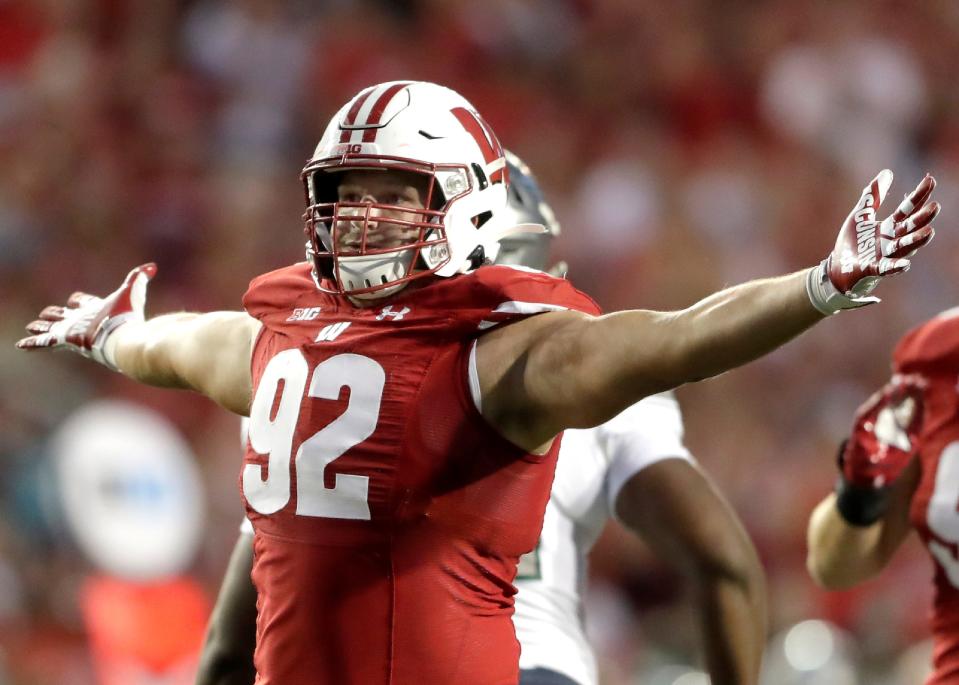Ex-Badgers lineman Matt Henningsen, now in the NFL, contributes to groundbreaking brain-surgery science

The NFL is hard, but it's not brain surgery. Matt Henningsen contributes to brain surgery on the side, though.
The former University of Wisconsin defensive end began his second NFL season last weekend, getting credit for a tackle in the Denver Broncos' 17-16 loss to Las Vegas.
He also be happens to be on a six-person team from UW-Madison that has developed a machine-learning network that can help neurosurgeons mitigate the impact of cerebral hemorrhaging.
No big deal.
"The newsworthy part ... is acceptance of the work by a peer-reviewed journal, (which) really is necessary for it to have impact," said Walter Block, a professor of biomedical engineering, medical physics & radiology at the university.
"Now, neurosurgeons who are designing the next ICH (intracerebral hemorrhage) national surgical trial can consider this work to, number one, use MRI (magnetic resonance imaging) instead of CT (computed tomography) to guide the surgeries and blood lysing and removal. Two, (they can) use our tool to guide surgeons at intervals throughout the treatment."
To attempt putting it more simply:
More than 100,000 people in the United States suffer intracerebral hemorrhaging every year, a catastrophic type of stroke that results often in death or long-term extended care. But the long-term impacts can be dramatically reduced if surgeons can remove the blood quickly.
It's just not that easy to locate and remove quickly, and it comes with the risk of greater injury to the brain.
So the team at Madison created a machine-learning network using MRIs to make it easier. The group was led by Thomas Lilieholm, a Ph.D. student in the department of medical physics, and included associate professor of neurological surgery and radiology Azam Ahmed, radiology department fellow Matthew Larson, radiology and medical physics professor Alan McMillan, Block and Henningsen, who has a bachelor's and masters degree in electrical engineering.
A national trial showed that long-term patient independence was improved when doctors were able to remove the hemorrhaged blood from the brain so 15 milliliters or less remained.
“People are trying these minimally invasive surgical techniques, putting catheters in to remove the blood," Henningsen said in 2021 about the project. "And what people have determined is that you need to remove enough of it for it to have a significant effect on the independence of the person.
"The person is never going to be the same, but rather than being in a nursing home, the hope is that you could have them live at home with some assistance."
More than a year after he left UW, the peer-reviewed part has now come through.
"Getting this work all accepted by a medical imaging journal took about 15 months after he graduated," Block said. "As UW Health is not a hospital the size of Mass General or Mount Sinai, we didn’t have as many ICH images to train on or to test. That slowed down the approval process by the journals in this area."
What exactly did Matt Henningsen do for the project?
Henningsen worked with a neuroradiologist fellow to identify areas of blood clots and swelling on MRIs showing the hemorrhaging.
The group studied 27 patients, and each could have as many as 40 cross-sectional images showing these areas, termed Regions of Interest. It was Henningsen's job to draw outlines of the ROIs on the images.
Henningsen then put those images in a format that the machine-learning algorithm could use as a data set to identify the brain clots on its own. Essentially, Henningsen's work could be used as a baseline to evaluate the machine's accuracy and was also used to train the machine in the first place.
"Matt used this experience of developing training data with us later in his masters work to develop his own machine-learning algorithms during his last year on campus," Block said.
"By his last year on campus as an MS student, he had developed enough experience in signal processing and computing to build his own machine-learning networks. If he so chooses, he could use this experience in some really complex areas of brain mapping, such as characterizing how brain networks are organized and coordinate themselves."

Henningsen played in 17 games for the Broncos last year
It just so happens Henningsen is also good at football.
Last year, he appeared in 17 games for the Broncos and finished with 21 tackles, playing 20% of the team's defensive snaps and 40% of its special-teams snaps.
It's part of a meteoric rise for the Menomonee Falls High School graduate, a former walk-on at UW who was taken in the sixth round of the 2022 draft.
He became the first Wisconsin walk-on since at least 1990 to start a season-opener as a freshman in 2018 and went on to play 42 games at Wisconsin, earning third-team All-Big Ten as a senior in 2021.
This isn't going to shock you, but he also earned a spot on the College Sports Information Directors of America All-District team in 2021. He graduated with a 4.0 grade-point average in electrical engineering and is a three-time Academic All-Big Ten choice in football and a National Football Foundation scholar-athlete.
“When he talks about doing something, he talks about doing it at the highest level,” UW football coach Paul Chryst said in 2021. “It’s not just checking the box and (saying): I’ve got that done. Whether it is his school work, whether it is in his training or in his play.
“There’s a guy that is completely all-in, and the energy that he brings and gives to others and the awareness that he has for teammates and everyone around, that’s impressive.”
Jeff Potrykus contributed to this story.
This article originally appeared on Milwaukee Journal Sentinel: Ex-Badger Matt Henningsen, now with Broncos, on UW brain-science team

